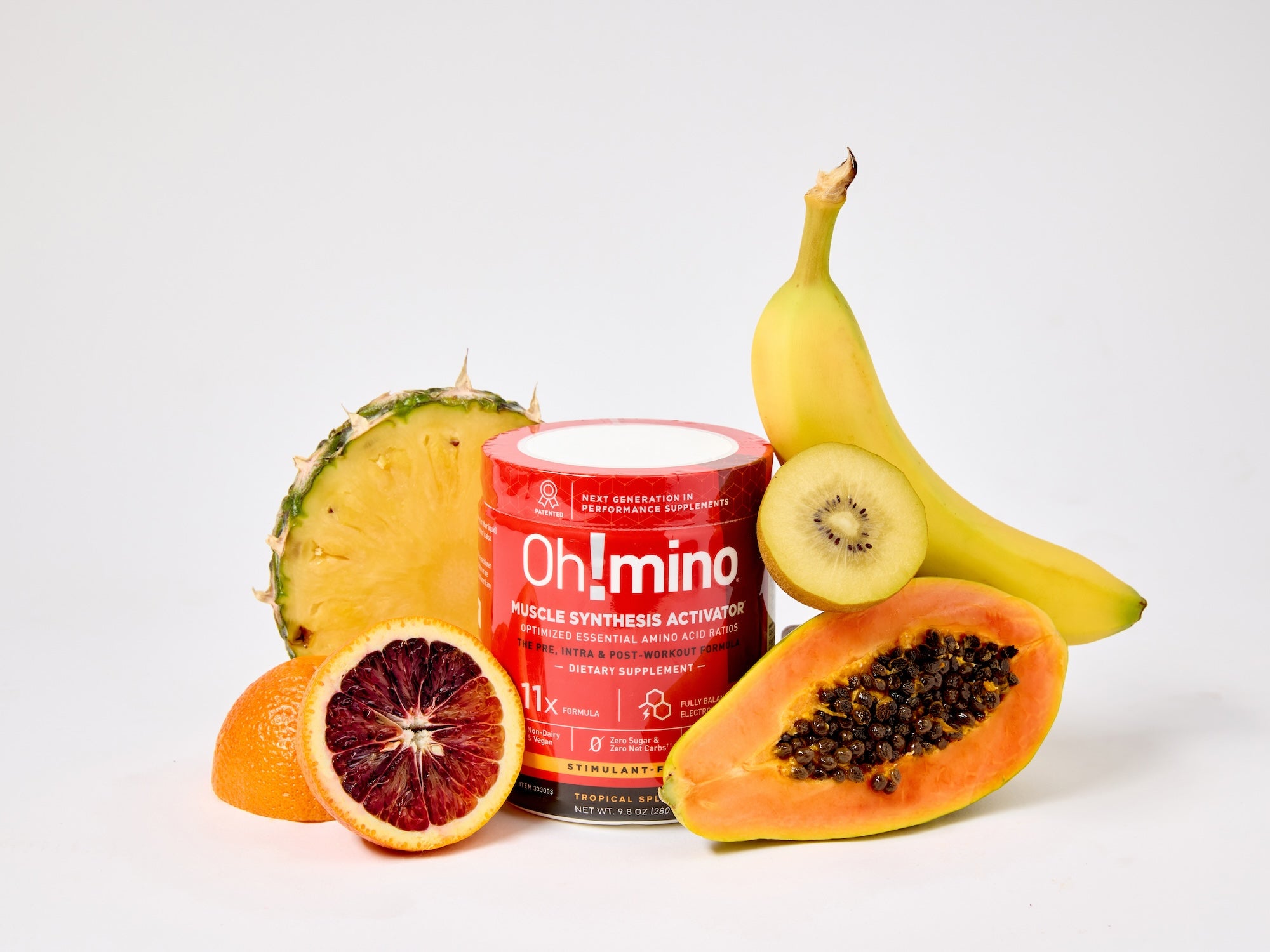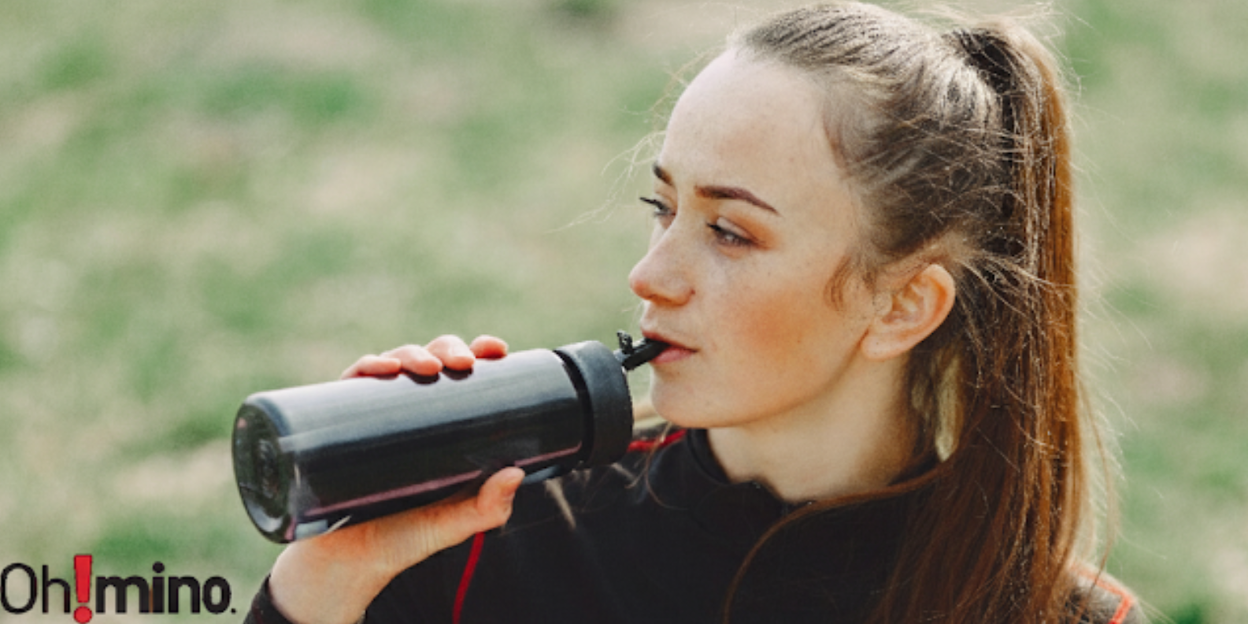Key Takeaways
-
Pedro Pascal's arm transformation for roles like Joel in The Last of Us involved a focused combination of bicep, tricep, and shoulder exercises.
-
Strategic training frequency optimizes results. Training arms 2–3 times weekly through push-pull splits allows for optimal stimulus while ensuring 48–72 hours recovery between sessions targeting the same muscle groups.
-
Body composition matters as much as muscle building. Pascal's visible definition requires maintaining low body fat through strategic nutrition while consuming adequate protein (1.6–2.0 g per kg bodyweight) to support muscle development.
-
Oh!mino® Muscle Synthesis Activator provides the complete amino acid profile Pascal's training demands, delivering all nine essential amino acids plus balanced electrolytes to support enhanced muscle recovery, reduce soreness, and maintain hydration during intense arm training sessions.
Pedro Pascal's Arm Transformation: From Actor to Action Star
While Pedro Pascal has always maintained a fit physique throughout his career, his recent arm development represents a targeted approach to muscle building.
The transition began during preparation for The Last of Us, where he needed to portray a character with the physical capability to survive in a post-apocalyptic world. He wasn’t trying to become a huge bodybuilder—he was working toward functional, defined arms that conveyed capability and strength.
What makes Pascal's arm development particularly noteworthy is his balanced approach. His biceps show clear definition without excessive size, his triceps provide that enviable horseshoe shape when flexed, and his shoulders create that capped look that makes t-shirts fit perfectly.
This is the result of training all three muscle groups with equal attention rather than focusing exclusively on the show muscles. The key to understanding Pascal's transformation is recognizing that it combines two essential elements: muscle building through progressive resistance training and sufficient leanness to reveal the definition.
Without both components working together, you won't achieve that same aesthetic. Many people make the mistake of focusing exclusively on arm exercises without addressing body composition, which explains why their results don't match what Pascal has achieved.
|
Oh!mino©: Elevate Your Performance. Accelerate Your Recovery. Science-Backed Superiority for Every Fitness Journey Power Your Goals with Proven Results:
The Oh!mino® Advantage: ✓ Patented formula that’s 11x more effective than protein, 20x more effective than BCAAs Choose Your Perfect Formula: Available in refreshing Tropical Slash or Berry Blast flavors, with stimulant-free or caffeinated options. Prefer capsules? We've got you covered with the same powerful formula. Take before, during, or after training—one solution for your entire workout. |
The Complete Pedro Pascal Arm Workout

Pedro Pascal does a comprehensive workout routine to build his arm strength (Source: metro)
Bicep Exercises That Built Pascal's Definition
The foundation of Pascal's bicep development comes from compound pulling movements that engage the biceps while also working larger muscle groups.
Begin with 3-4 sets of 8–10 reps of pull-ups or chin-ups, focusing on a full stretch at the bottom and complete contraction at the top. These bodyweight movements create the foundation of bicep strength and development. Follow with bent-over rows for 3 sets of 8–10 reps, which engage the biceps as secondary movers while developing the entire posterior chain.
-
Barbell curls: 3 sets of 8–10 reps (focus on full range of motion)
-
Alternating dumbbell curls: 3 sets of 10–12 reps per arm
-
Hammer curls: 3 sets of 10–12 reps (targets brachialis for arm thickness)
-
Spider curls: 2–3 sets of 12–15 reps (creates peak contraction)
Tricep Movements for Complete Arm Development
Pascal's arm development showcases the importance of prioritizing triceps, which comprise roughly two-thirds of your upper arm mass. His workout focuses on hitting all three heads of the triceps (long, lateral, and medial) to achieve that full, horseshoe shape visible when his arms are extended or flexed.
Start with compound pressing movements that heavily recruit the triceps while also engaging the chest and shoulders. Close-grip bench press is particularly effective, performing 3–4 sets of 8–10 reps with elbows tucked close to the body. Dips are another foundational movement, with 3 sets of 8–12 reps focusing on tricep engagement by keeping the torso more upright.
Shoulder Work That Enhances Arm Appearance

A key element often overlooked in arm development is proper shoulder training.
Pascal's defined deltoids create that capped appearance that makes his arms look impressive from every angle. Well-developed shoulders provide the foundation that makes biceps and triceps pop visually, completing the total arm aesthetic.
The shoulder routine focuses on all three deltoid heads (anterior, lateral, and posterior) to create balanced development. This prevents the rounded-shoulder look that can come from overemphasizing certain movements and instead creates that broad, athletic appearance Pascal displays.
Progressive Overload: How to Build Strength Over Time
The secret to Pascal's arm development isn't just exercise selection but how he implements progressive overload—the gradual increase of stress placed on the body during training.
Rather than simply adding weight each session, your approach should vary between increasing resistance, adjusting tempo, adding volume, or decreasing rest periods.
This methodical progression prevents plateaus while minimizing injury risk. For example, instead of jumping from 25-pound to 30-pound dumbbells for curls, you might first increase from 3 sets of 8 reps to 3 sets of 10 reps with the 25-pound weights. Only after mastering that would he increase the weight while dropping back to fewer reps.
Training Schedule: How Often Pascal Works His Arms
Pascal's arm training follows a strategic frequency that allows for optimal stimulus while ensuring proper recovery. Rather than dedicating entire workouts to arms alone, he incorporates arm training into a broader upper body push-pull routine.
This approach hits arm muscles directly and indirectly multiple times per week while still allowing sufficient recovery between intense sessions. A typical weekly split looks like this: Monday for pushes (including triceps), Tuesday for pulls (including biceps), Wednesday for legs and core, Thursday for pushes, Friday for pulls, and weekends dedicated to active recovery like hiking or mobility.
This frequency allows each muscle group to be trained 2–3 times weekly with varying intensity and volume.
Nutrition Principles Behind Pascal's Lean Arms

Pascal’s nutritional approach affects arms just as much as exercise.
Protein Requirements for Muscle Definition
Protein intake is the cornerstone of any nutritional approach, consuming approximately 1.6–2.0 grams per kilogram of bodyweight daily. This provides the amino acids necessary for muscle repair and growth following training sessions. Sources include amino acid supplements, lean meats, fish, eggs, Greek yogurt, and plant-based options like legumes and tofu to ensure a complete amino acid profile.
Timing matters almost as much as total intake. Prioritizes protein consumption within 1–2 hours post-workout to take advantage of increased muscle protein synthesis.
Strategic Carb Timing
Carbohydrates aren't villains in the nutrition plan but are consumed strategically around training windows. The majority of his carbohydrate intake occurs in the pre-workout meal (1–2 hours before training) and immediately post-workout to replenish glycogen stores and support recovery.
On non-training days or further from workout windows, carbohydrate intake is moderately reduced while protein remains consistent.
Hydration's Role in Muscle Recovery
Often overlooked in muscle development discussions is proper hydration, which Pascal takes seriously. He maintains a water intake of approximately 1 ounce per pound of bodyweight daily, with increased consumption surrounding workout periods.
Proper hydration maintains optimal blood volume for nutrient delivery to muscles and supports the metabolic processes necessary for recovery.
Common Arm Training Mistakes to Avoid
Neglecting Triceps (The Bigger Muscle Group)
The most common mistake in arm training is overemphasizing biceps while undertreating triceps, despite triceps comprising approximately two-thirds of upper arm mass.
Another tricep training error is using too narrow an exercise selection. A good routine includes movements that target all three tricep heads through various angles and loading patterns.
This comprehensive approach prevents the development plateaus that come from repeatedly performing the same limited exercise selection.
Using Momentum Instead of Control
Watch footage of Pascal training, and you'll notice the controlled tempo and full range of motion on every repetition. This contrasts sharply with the common mistake of using momentum to move weights, particularly on bicep exercises like curls.
Controlling the eccentric (lowering) portion of each movement and eliminating swinging or body English ensures the target muscles do the work rather than momentum.
Insufficient Recovery Between Sessions
Effective arm development requires sufficient recovery between training sessions. The mistake many make is training arms too frequently with too much volume, not allowing the repair processes necessary for growth.
You should typically allow 48–72 hours between sessions that target the same muscle groups directly, ensuring complete recovery while maintaining frequency.
Oh!mino's Supplement for Pascal-Level Arm Development
Oh!mino® Muscle Synthesis Activator serves as the perfect training companion for those pursuing Pascal-level arm development. Our scientifically formulated patented blend delivers all nine essential amino acids your muscles demand for optimal protein synthesis, including the critical branched-chain amino acids leucine, isoleucine, and valine that directly support muscle growth and recovery.
The inclusion of five fully-balanced electrolytes ensures proper hydration and nutrient transport throughout extended training sessions. Simply mix 1–2 scoops with 8–12 ounces of water and consume before, during, or immediately after your arm training for maximum muscle synthesis activation.

Oh!mino® Muscle Synthesis Activator provides immediate fuel during those intense bicep, tricep, and shoulder sessions that Pascal's routine demands.
Pascal's transformation didn't happen overnight, and yours won't either. But with consistent application of proven training principles and the right nutritional support, those head-turning arms are absolutely within reach. Use our Muscle Synthesis Activator to gain strength, build muscle, and recover faster.
The same dedication Pascal brought to preparing for Joel can drive your own transformation, one progressive workout at a time.
Try Oh!mino® Muscle Synthesis Activator Today!
Frequently Asked Questions
How long did it take Pedro Pascal to develop his impressive arm definition?
Based on public appearances and filming schedules, Pascal's most notable arm transformation occurred over 8–12 months of dedicated training. His development became most visible around the 6-month mark, though he built on an existing fitness foundation from previous physical roles, which accelerated his progress compared to complete beginners.
Can I achieve Pascal's arm development without going to a gym?
Absolutely. Pascal's arm aesthetic can be developed through progressive calisthenics including push-up variations, pull-ups, and dips, combined with minimal equipment like adjustable dumbbells and resistance bands. The key is applying progressive overload principles consistently, regardless of the training environment.
What role does nutrition play in achieving visible arm definition like Pascal's?
Nutrition is crucial for revealing muscle definition. Pascal maintains 10–15% body fat through strategic whole food consumption, emphasizing lean proteins, complex carbohydrates around workouts, and consistent hydration. Visible definition requires both muscle development and low enough body fat to showcase the underlying musculature.
Should I prioritize biceps or triceps for better arm development?
Triceps should receive equal or greater attention than biceps since they comprise roughly two-thirds of upper arm mass. Pascal's routine dedicates at least equal volume to triceps, often more, which creates the substantial arm appearance visible in his fitted clothing and red carpet appearances.
How can Oh!mino® Muscle Synthesis Activator support my Pedro Pascal-inspired arm training?
Oh!mino® Muscle Synthesis Activator is specifically designed to enhance the type of intensive arm training Pascal uses. With all nine essential amino acids including the crucial BCAAs (leucine, isoleucine, valine), it supports muscle protein synthesis more effectively than incomplete protein sources.
Simply mix 1–2 scoops with 8–12 oz of water and consume before, during, or after your Pascal-inspired arm workouts to maximize muscle development and minimize downtime between sessions.





